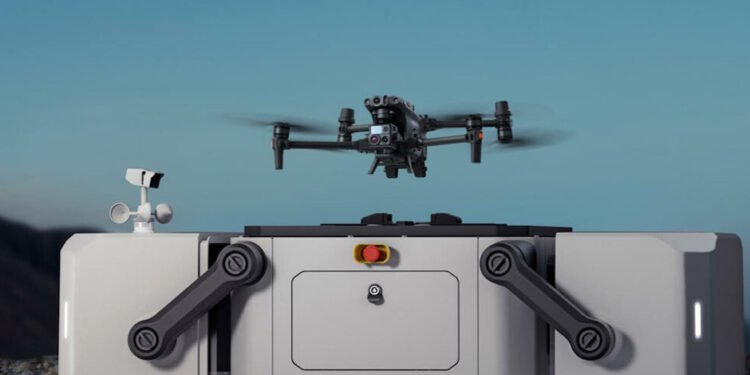Drones are increasingly pivotal in numerous sectors, including agriculture, logistics, emergency response, and environmental monitoring. As these unmanned aerial vehicles (UAVs) take on more complex and longer missions, the development of drone docks has become essential. These specialized stations, like a Skydio Dock, allow drones to recharge and facilitate automated landing, maintenance checks, and data transfer, significantly expanding their operational capabilities.
Technological Foundations of Drone Docks
Drone docks are engineered with cutting-edge technology designed to support autonomous operations. Key features include precision landing systems that guide the devices to safe docking without human intervention and rapid charging capabilities that minimize downtime. Recent advances have introduced high-efficiency energy storage systems that can quickly replenish batteries, ensuring that UAVs are ready for their next task sooner.
Innovations in Energy Storage and Transfer
Modern hubs often incorporate advanced energy solutions such as ultra-fast charging batteries and even solar power options. These innovations help reduce the environmental impact of drone operations and enhance the sustainability of the docking stations. By leveraging renewable energy sources, docks can operate in more remote locations, thus broadening the potential uses in various fields.
Enhancing Drone Endurance and Range
One of the primary benefits of docks is their ability to extend UAVs’ operational range and endurance. Traditional battery limitations mean that drones must return to base frequently for recharging, but with the strategic placement of docks, unmanned vehicles can accomplish longer missions over extended areas.
Integration into Existing Drone Operations
Incorporating these stations into existing UAV fleets presents both challenges and opportunities. Operators must consider the logistical aspects of dock placement and integration with flight software. Compatibility between different models and the docking systems requires standardized or adaptable interfaces to ensure seamless operation. Training for personnel on the new system is essential, as it involves understanding dock maintenance and troubleshooting potential issues. The data collected during missions needs to be securely integrated into existing data management systems, ensuring that information flow remains continuous and protected.
Strategic Advantages of Drone Stations
Strategic implementing hubs like a Skydio Dock can significantly enhance operational efficiencies. By enabling drones to fly longer and more frequently, these docks reduce the need for large fleets, thereby saving costs on purchase and maintenance.
Increased Asset Utilization
With such strategically positioned docks, these devices can achieve more in less time, effectively increasing asset utilization. This improvement allows operators to maximize the output, significantly reducing idle time as the UAVs can quickly recharge and redeploy. This efficient cycling through tasks ensures a higher return on investment for the expensive drone technology, as each unit can cover larger areas or complete more tasks within the same operational hours.
Reduced Operational Downtime
These stations minimize the operational downtime associated with battery depletion. By shortening the charging time and making recharging stations more accessible during missions, they can maintain near-continuous operation. This is particularly beneficial in time-sensitive applications such as delivery services or during emergency response operations, where every minute counts. The reduced downtime speeds up operations and enhances the responsiveness of services that rely on UAV technology.
Enhanced Safety and Risk Management
Implementing drone docks can also lead to enhanced safety and better risk management. Drones are less likely to experience battery depletion mid-flight, which can be hazardous in urban or populated areas. Additionally, regular docking provides opportunities for automated systems checks and maintenance routines, ensuring each device is in optimal condition before take-off. This proactive maintenance approach helps prevent accidents and malfunctions, further protecting investments and enhancing the overall safety of operations.
Cost-Effectiveness and Competitive Edge
Businesses that employ such stations can achieve a quicker return on investment due to the increased efficiency and reduced operational costs. Moreover, maintaining continuous operations gives companies a competitive edge, which is essential in industries where timely data collection and processing are crucial.
Potential Developments
The future of docks looks promising, with several potential technological advancements. Innovations such as solar-powered docks and AI-enhanced operations are expected to drive the next wave of efficiency in technology. The incorporation of artificial intelligence could lead to smarter docking systems that automatically diagnose and repair common issues, reducing the need for manual maintenance. Additionally, expanding solar energy use within docks can facilitate more sustainable and autonomous operations, especially in remote or underserved areas.
Drone docks are transforming the landscape of UAV operations by enhancing the capabilities to perform longer and more complex missions. The advancements in technology will unlock new possibilities for the use of drones across various industries. The integration of advanced energy solutions, AI, and improved regulatory frameworks will further establish drone docks as crucial components of modern aerial operations. Embracing these innovations will extend the operational limits of the device and pave the way for more sophisticated and sustainable uses of UAV technology in the future.












